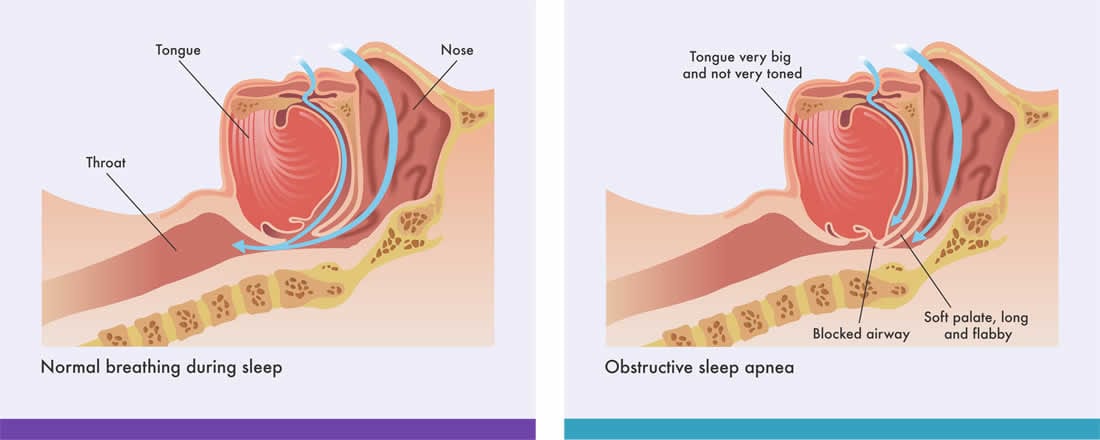Obstructive Sleep Apnea (OSA) – What is it?
Sleep apnea is a sleep disorder characterized by pauses in breathing or instances of shallow breathing while you sleep, called apneas. Each apnea can last anywhere from a few seconds to several minutes and may occur 30+ times each hour. During these pauses, your airway relaxes, and you are unable to receive enough air to your lungs, causing snoring. Typically an apnea is followed by a loud gasp for air as you are trying to catch your breath. People with the disorder tend to suffer from fatigue and daytime sleepiness due to the disruption of deep sleep throughout the night.

Symptoms
Symptoms of central and obstructive sleep apnea often overlap, but here are a few of the most common signs and symptoms of this sleep disorder:
- Loud snoring, most common in the obstructive form of the disorder.
- Excessive daytime sleepiness
- Episodes of breathing cessation during sleep (observed by another person)
- Abrupt awakenings accompanied by shortness of breath
- Awakening with a dry mouth or a sore throat
- Morning headaches
- Difficulty staying asleep
- Irritability
What causes it?
Sleep apnea can affect anyone, even children. The signs of sleep apnea are often overlooked by physicians and patients alike. Why? Because they are very broad and can be mistaken for signs of other problems. One of the most common and easily identified signs of sleep apnea is loud and ongoing snoring. While asleep, pauses in breathing may occur, sometimes followed by choking or gasping for air – these are called apneas. Frequently, people do not realize they are having these apneas until a partner complains about snoring. It’s important to note that not everyone who snores has sleep apnea. However, certain factors may increase your risk of having a sleep disorder. For obstructive sleep apnea, the most common, some of them include:
- Excess weight: people with excess weight have four times the risk of having the sleep disorder; fat deposits around the upper airway may obstruct breathing.
- Family history: if people in your family have sleep apnea, you may have an increased risk of having it.
- Gender: men are twice as likely to have it.
- Getting older: sleep apnea occurs more often in older adults.
- Smoking: Smoking can increase the amount of inflammation and fluid retention in the upper airway, putting you at risk for having the sleep disorder.
Possible solutions
CPAP therapy is one of the most common treatment methods technologists, and sleep physicians recommend to those who have sleep apnea. However, there are several alternative sleep apnea treatment options available that may be helpful depending on your specific needs.
- Oral/Dental Appliance – Oral sleep apnea treatment devices prevent the airway from collapsing by holding the tongue in position or by sliding your jaw forward so you can breathe while you sleep. Oral appliance therapy is typically recommended for people with mild to moderate sleep apnea who cannot tolerate CPAP.
- Positional Therapy – If you have sleep apnea primarily when you’re sleeping on your back, but your breathing returns to normal when you sleep on your side, positional therapy may help. It involves wearing a special device around your waist or back to keep you sleeping in the side position. In a clinical study published in 2012, scientists tested the long-term efficacy of this therapy and found that positional therapy can be an effective form of treatment.
- Weight Loss – If you have a thick neck with extra tissue in the throat that blocks the airway, weight loss may reduce this tissue. There is no guarantee that losing weight will eliminate your sleep apnea, though it may help.
- Surgery for Sleep Apnea – Surgery is the most common option to reduce or eliminate the extra tissue in your throat that collapses and blocks your airway during sleep. Keep in mind that while some surgeries may be minimally invasive, others can be more complex. In many cases, the benefits may not be permanent. Sleep apnea may reoccur at a later time for some people. Surgical therapies are often not as effective in treating sleep apnea as CPAP and oral appliances.
- Lifestyle Changes – There are a variety of lifestyle changes that you can make to help reduce your snoring and improve your sleep apnea symptoms. Behavioral changes such as quitting smoking or not drinking alcohol may improve sleep apnea symptoms. If you have allergies, taking a decongestant before you go to bed may help improve airflow through your nose.
- Cognitive Behavioral Therapy – A behavioral sleep specialist might be able to help you eliminate any thoughts and behaviors that may be preventing you from getting restful sleep or complying with other treatment
Why get treatment?
The problem goes well beyond simply not getting a good night’s sleep. Without proper diagnosis and treatment, obstructive sleep apnea can have some serious implications. It can also increase the risk of stroke, obesity, depression, diabetes, and high blood pressure. An evaluation of 100 patients (84 men and 16 women) with an average age of 50 years showed how common it is for obstructive sleep apnea patients to suffer from other ailments. Hypertension is the most common condition that can be caused by obstructive sleep apnea with 39% of the 100 patients afflicted. Other notable conditions include obesity, which affects 34%, depression which affects 19%, and GERD which affects 18% of the 100 patients.
In addition to treating sleep apnea, studies have also shown that a continuous airway pressure (CPAP) device can also help to reduce the symptoms of GERD.
